Auditoría de Google Ads: ¿Cómo auditar una cuenta?
Durante nuestros años en Google y otras empresas hemos visto un número de cuentas muy amplio, con múltiples métodos de gestionar las campañas de Adwords. Este artículo de Auditoría de Google Ads (primera parte) pretende mostrar que conceptos se han de tener en cuenta de cara a mejorar el desempeño de las cuentas de publicidad en Google desde un punto de vista técnico y Operacional. En esta primera parte analizaremos tres áreas fundamentales de una cuenta de Google Ads: La estructura de campañas así como la selección de Palabras clave y las redes empleadas.
1. Auditoría de Google Ads: estructura de campañas de nuestra cuenta.
La estructura de las campañas es el punto crítico y principal de una campaña en Adwords de máxima calidad. Todo el tiempo invertido en definir, segmentar y configurar una cuenta de AdWords nos permitirá ser más eficientes a la hora de optimizar la cuenta y obtener mejores resultados. La hiper-segmentación que realizamos en Digital Menta junto a otras acciones, hacen que nuestras estructuras de cuenta maximicen la inversión de nuestros clientes. Utópicamente una cuenta tiene que tener un anuncio por cada keyword. Esto era inmanejable con cuentas de miles de palabras claves, pero actualmente gracias al machine learning que el propio Google nos facilita, la tarea de la hipersegmentación es ahora mucho más fácil y nos ayuda a obtener mejores resultados.
Además de la hipersegmentación, tener una estructura de cuenta coherente también nos ayudará a servir el anuncio adecuado para el usuario adecuado. Un punto importante a tener en cuenta es el balance entre una campaña hipersegmentada y la manejabilidad operativa de esta. Deberíamos hacernos las siguientes preguntas para auditar la estructura de AdWords.
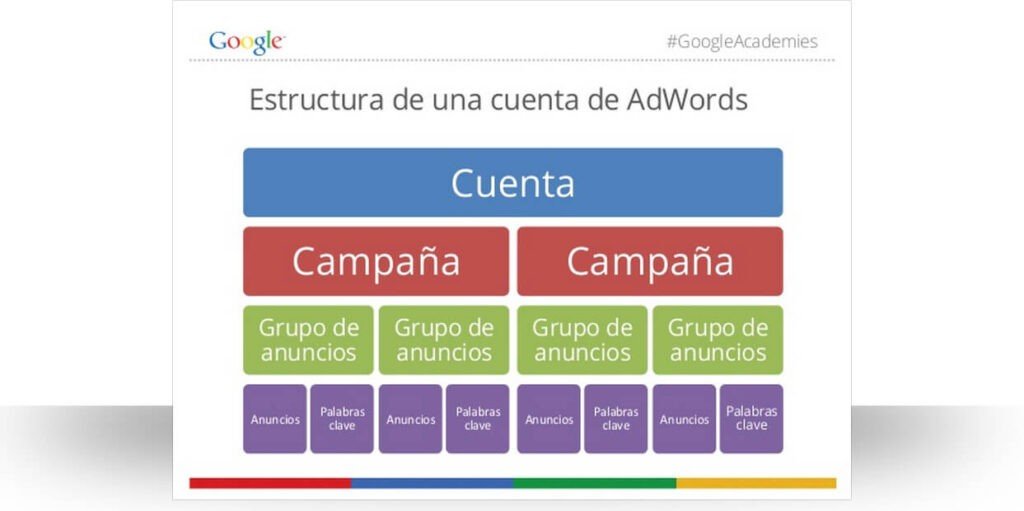
Estructura de AdWords básica propuesta por Google Academies
¿Grupos de anuncios muy segmentados?
Cada producto / categoría / subcategoría / marca deben tener un grupo de anuncios dedicado. También existen diferentes maneras de segmentar por Regiones, tipos de KWs, matchTypes, etc…
¿Palabras clave muy segmentadas?
Las listas de palabras clave deben estar herméticamente agrupadas en torno al tema específico del grupo de anuncios. Si incluyes nuevas palabras clave que no se ajustan a ninguno de los grupos de anuncios, recomendamos crear un nuevo grupo de anuncios para agrupar de forma coherente.
Evaluar el número de keywords por grupo de anuncio
No podemos definir un número concreto de palabras clave a mantener en un grupo de anuncios, pero sí sabemos que este variará en función de la estrategia que estemos siguiendo. Si estamos apoyándonos en herramientas de machine learning, probablemente es mejor aglutinar palabras clave y con ellas tráfico y datos y así ayudar a los algoritmos a que trabajen eficientemente. En cambio, si queremos tener un control absoluto del rendimiento por marca/producto/modelo etc. siempre nos ayudará tratar de segmentar al máximo en la medida de lo posible.
Productos/marcas/modelos divididos estrictamente en grupos de anuncios/campañas
La segmentación en productos, marcas o modelos nos permitirá controlar mejor las campañas y sus presupuestos desde el punto de vista del negocio. Otra de las dimensiones a controlar con diferentes campañas sería la geográfica.
Campañas separadas por Zonas Geográficas
No es lo mismo una campaña para Colombia que una para México. Del mismo modo que puede que la publicidad para Madrid funcione de manera totalmente diferente a la de Galicia. En ese caso, sería interesante diferenciar las campañas por segmentación geográfica y así controlar mejor los presupuestos. Es otra dimensión que tiene sentido analizar y valorar si aplicarla en la estructura de nuestras campañas.
La Estructura refleja el Site
Otro de los factores a tener en cuenta es la estructura del sitio web ya que nos permitirá crear campañas con enlaces profundos específicos y tener control sobre cada producto específico como categoría / marca , etc.
Lógica en la creación de campañas, anuncios y estructura
Aplicar una coherencia a la hora de crear una estructura hará que sea más fácil entender las campañas, ejecutar cambios en ella y hacer análisis del rendimiento.
2. Auditoría de Google Ads: selección de Palabras Clave en las campañas de nuestra cuenta.
Una buena selección de las palabras claves, los tipos de concordancia, la agrupación de éstas en la estructura creada y la selección de palabras clave negativas son puntos cruciales de una estrategia de AdWords adecuada. Este proceso hará que invirtamos el dinero de la manera más eficiente posible desde el principio.
Además, tenemos que tener en cuenta la novedad que ha introducido Google recientemente sobre las concordancias de las palabras clave. En las próximas semanas veremos cómo sinónimos de nuestras keywords en concordancia amplia y de frase pasarán a ser búsquedas que activarán la impresión de nuestro anuncio. Recomendamos tener en cuenta esta novedad al hacer un nuevo set up para una cuenta nueva.
Matchtypes diferentes alineados con los objetivos
Cuanto más específico el tipo de concordancia más eficiente será el rendimiento, pero más pequeño es el grupo objetivo / volumen de impresiones / clics etc. Por eso, hay que tener diferentes matchtypes para controlar la eficiencia de la campaña sin reducir el volumen de impresiones.
¿Existen Palabras clave negativas?
Se deben añadir palabras clave negativas para evitar que se muestren para las consultas de búsqueda que no son pertinentes . Tened cuidado con el tipo de concordancia es importante no entrar en conflicto con kws positivas. Las keywords negativas cruzadas entre diferentes Grupos de anuncios son importantes para afinar al máximo la impresión de los anuncios correctos. La selección de palabras claves negativas se tiene que hacer con cabeza, ya que se pueden incluir palabras clave negativas que limiten las impresiones de nuestros anuncios con búsquedas aptas. Una manera interesante de gestionarlas es crear listas de kws negativas para hacer la operativa más sencilla.
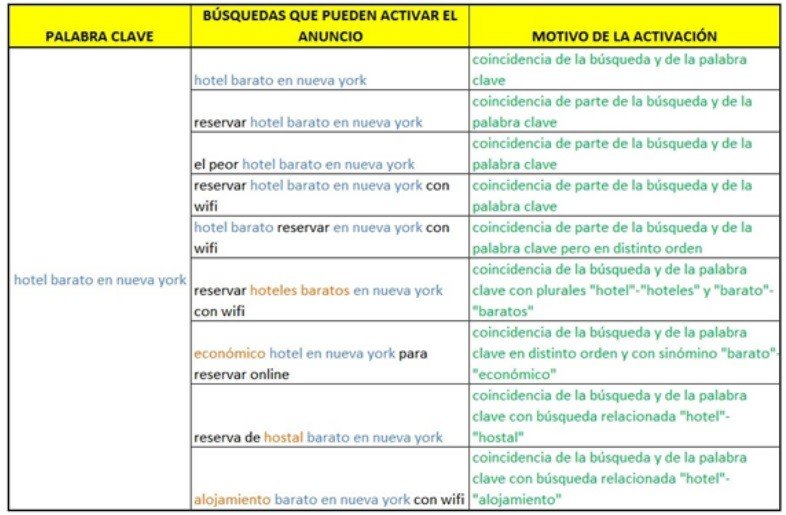
Ejemplo de KWs negativas by HotelJuice.com
Evidencia de que se incluyen nuevas keywords negativas cada poco tiempo
Añadir palabras clave negativas evidencia que se están haciendo cambios en la cuenta de manera constante buscando no mostrar nuestros anuncios ante búsquedas que no son interesantes. Añadir palabras claves negativas a nuestra cuenta tiene que ser una tarea constante.
¿Palabras clave duplicadas?
Se ha de comprobar que no hay palabras clave duplicadas. Las palabras clave duplicadas en diferentes campañas/grupos de anuncios hacen que las estadísticas de análisis se desvirtúen, que no se controle correctamente el mensaje a mostrar y sea Google quién decida que anuncio mostrar en cada caso según su criterio e incluso encarecer las pujas al estar compitiendo en tu propia cuenta.
Brand Exact match Impression Share al 100%
Tenemos que capturar toda la demanda de nuestras keywords de marca en búsqueda si nuestra estrategia pretende defender la marca u obtener una comunicación diferente con nuestros usuarios que no permitiría el SEO.
¿Palabras clave de long tail en la cuenta?
Estas son las palabras con poco volumen de búsquedas pero que hacen que la cuenta funcione de manera más eficiente. Las palabras clave long tail tienen que tener anuncios de texto lo más específicos posibles.
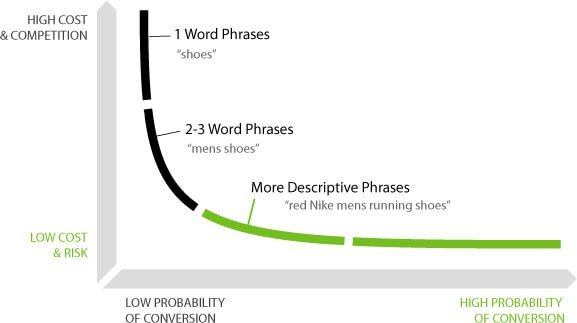
Explicación de Keywords de Long Tail
¿Palabras clave sin impresiones o con muy pocas?
No debemos confundir palabras long tail, con keywords con volúmenes de impresiones y rendimiento bajos en las campañas o grupos de anuncio, ya que estas keywords generan bajo CTR (negativo en el sentido del nivel de calidad) y deben eliminarse (precaución con esto).
3. Auditoría de anuncios y extensiones de nuestra cuenta de Google Ads
Adtext
Otro punto crítico de la eficiencia de las campañas de publicidad son los anuncios. Su redacción debe tener dos aspectos fundamentales para maximizar la eficiencia de las inversiones; por un lado respetar la línea de comunicación definida por la marca e incitar al usuario a querer conocer más y por otro lado la relevancia con las palabras clave definidas en cada uno de los diferentes grupos de anuncios.
¿Número de anuncios por adgroup?
Lo más recomendable es tener varios anuncios que se vayan mostrando y hacer seguimiento de la tasa de clic y de la tasa de conversión para ver qué argumentos son los más adecuados. Podemos apoyarnos en tests de tipo AB y conocer qué tiene el mejor impacto a nivel de publicidad en nuestra cuenta.
Además, recomendamos incluir llamadas a la acción relevantes para ayudar a generar interés en el usuario.
Para seguir evaluando el nivel de perfeccionamiento de la cuenta, podemos comprobar si el anuncio incluye la keyword principal del grupo de anuncios, ya que esto nos ayudará a mejorar el CTR. Por otra parte, si hay uso de keyword insertion, debemos verificar que no hay faltas de ortografía en las keywords que estamos usando.
La URL visible del anuncio tiene que estar alineada con la búsqueda que se hace y ofrecer información relacionada con esta. No tiene por qué ser una URL real ya que será la URL final la que tenga que ser válida para enviar a los usuarios a la página de aterrizaje adecuada.
Sitelinks
Debemos verificar si todos los adgroups tienen extensiones de anuncios pertinentes y destacan textos acordes a la campaña. Los sitelinks deben tener una descripción extendida para mejorar el impacto de la publicidad y la captura del espacio en el buscador.
Extensiones de ubicación Geográficas; este tipo de extensiones son útiles para aquellas marcas que tengan establecimientos en diferentes ubicaciones. Estas extensiones son relevantes para usuarios que nos buscan a través del móvil y quieren conocer el establecimiento más cercano del negocio.
Extensiones de llamada; nos ayudan a encontrar negocios locales y favorece el tráfico a tienda.
Extensiones de reseña; son útiles para generar confianza en los usuarios a través de los comentarios o valoraciones de otros usuarios en fuentes de confianza
Extensiones de texto destacado; nos ayudan a incluir información relevante y definir los diferentes valores aportados por la empresa (precio, servicios al cliente etc.)
Extensiones de extractos de sitio: mostraremos en el anuncio parte de la gama de productos que tiene un anunciante, ya sea marcas, servicios etc…
Extensión de Aplicación; promocionaremos la app de nuestro negocio.
PD: si no podéis esperar podéis descargaros la guía de la auditoría de 50 puntos desde nuestro pop-up de la auditoría.
4. Redes
Las posibilidades de publicidad en AdWords permiten emplear múltiples formatos en diferentes redes (búsqueda, Red de Contenido de Google y Youtube). En función de las necesidades de cada anunciante se deberán usar unas u otras de manera acorde a los objetivos determinados en la estrategia. No obstante hay que tener en cuenta que cuantas más funcionalidades se empleen o se hayan probado, conoceremos mejor las posibilidades de Google Ads de generarnos ingresos.
Separar campañas de search y de GDN
Las campañas nunca deben unirse como una única. Las métricas de la red de Display de Google (Google Display Network o GDN) son completamente diferentes y por lo general buscan objetivos empresariales o de comunicación diferentes. Existe un tipo de campaña que se llama Display con Selección de búsqueda cuyo valor propuesto por Google es tener campañas en GDN que hereden la configuración eficiente de una campaña de búsqueda. Nosotros no solemos emplear este tipo de campañas por temas de eficiencia.
Google search vs search partners network
Si la red de Search de Partners funciona de manera inadecuada lo mejor es quitarla de la configuración. Este segmento se puede ver seleccionando el Segmento propio desde el interfaz de Google Ads. Lamentablemente Google solo nos permite activarlo o desactivar los search partners y no hacer ningún tipo de optimización.

Ejemplo de Análisis de Auditoría de AdWords de Segmento de Partners
Anuncios Banners de Display
Los anuncios gráficos en la red de Display son una buena manera de llegar a más usuarios y comunicar la propuesta de valor mientras los usuarios navegan por Internet. Gracias a las capacidades de segmentación de la red de Display se puede impactar de manera muy eficiente a los usuarios, ofreciéndoles una publicidad útil.
Límite de frecuencia en GDN campañas
El límite de frecuencia de las campañas de Display nos permite controlar mejor el mensaje a los usuarios y controlar el efecto que la marca deja en ellos. No hay un número mejor o peor en cuanto a limitación, simplemente hay que tenerlo en cuenta según la estrategia a seguir por la marca.

Configuración de limitación de frecuencia para la red de Display
¿Estrategia de Remarketing definida?
Debemos analizar si se está empleando una estrategia de remarketing en buscadores y redes de display, ya que es una herramienta fundamental para apoyar a la consecución de objetivos. Para ver si se está trabajando de forma adecuada, analizaremos la definición de los diferentes segmentos de audiencias y la creación de diferentes anuncios por segmentos. Ofrecer el mensaje adecuado a cada tipo de visitante hará que informemos de manera eficiente sobre nuestra propuesta de valor.
¿Segmentación de Display por género y edad?
Controlar las campañas por género y edad es fundamental para entender el comportamiento de los diferentes segmentos y poder acotar nuestra publicidad a aquellas personas que realmente puedan estar interesadas en nuestros servicios. Por ello, analizaremos si existe un comportamiento diferente entre edades o sexo y valoraremos la necesidad de separar campañas.
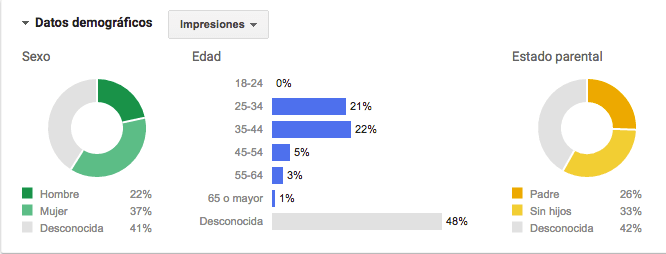
Auditoría AdWords por Edad y Sexo
Campañas de Vídeo de Youtube
Las campañas de vídeo en Youtube son altamente efectivas en cuanto a coste y nos permite también generar un mayor conocimiento de la marca. Asimismo, Youtube Analytics nos ofrece una información muy interesante sobre los usuarios que visualizan nuestros vídeos.
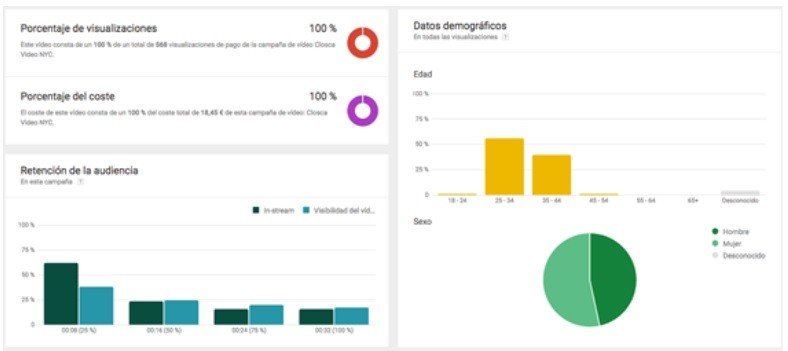
Auditoría de AdWords- Youtube analytics
Con este checklist podéis analizar si vuestro trabajo o el de vuestros socios (agencia o colaboradores) es adecuado y si se está exprimiendo todo el potencial de vuestra inversión en AdWords. Además, si lo que queréis es analizar detalles más completos podéis revisar nuestros artículos de AdWords.
La segunda parte de la auditoría de campañas de AdWords está a la vuelta de la esquina, así que estad atentos. Y aquellos que queráis compartir vuestro punto de vista sobre cómo auditar campañas de AdWords, ¡déjanos un comentario!



